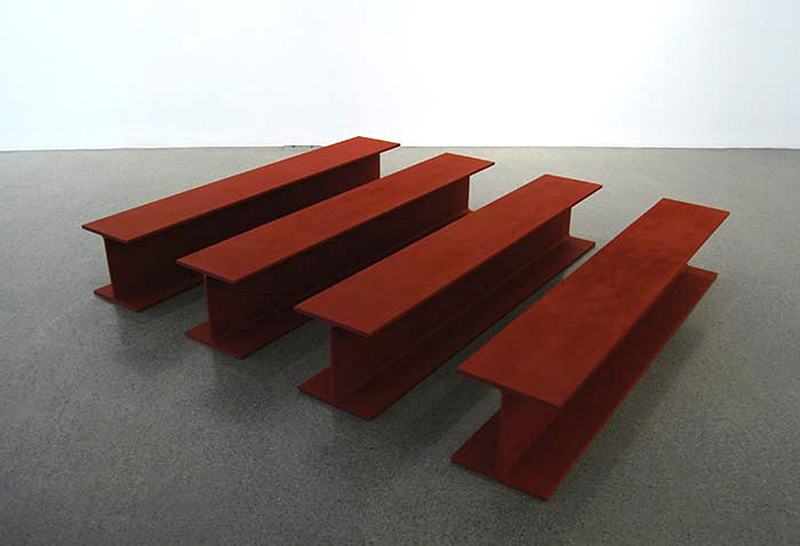ART-PRESENTATION: Rasheed Araeen-A Retrospective
 Rasheed Araeen is one of the foremost pioneers of Minimalist sculpture in Britain. As an artist, Araeen’s career had two beginnings: in Karachi as a civil engineering student practising painting, and again when the artist arrived in the United Kingdom in 1964. It was in that Araeen saw the group exhibition ”The New Generation”, at the Whitechapel Gallery featuring many artists who had been students of Anthony Caro, noting a turn away from Moore and Hepworth-esque figuration towards a Greenbergian form of modernist abstraction.
Rasheed Araeen is one of the foremost pioneers of Minimalist sculpture in Britain. As an artist, Araeen’s career had two beginnings: in Karachi as a civil engineering student practising painting, and again when the artist arrived in the United Kingdom in 1964. It was in that Araeen saw the group exhibition ”The New Generation”, at the Whitechapel Gallery featuring many artists who had been students of Anthony Caro, noting a turn away from Moore and Hepworth-esque figuration towards a Greenbergian form of modernist abstraction.
By Efi Michalarou
Photo: Van Abbemuseum Archive
“Rasheed Araeen: A Retrospective” that is on presentation at the Van Abbemuseum is the first comprehensive survey of the artist. Spanning 60 year of work the exhibition is structured across five chapters: from his early experiments in painting in Karachi in the 1950s and early 60s, his pioneering minimalist sculptures carried out after his arrival in London in 1964, key pieces from the 70s and 80s following Araeen’s political awakening, his nine panel cruciform works from the 80s and 90s and a selection of his new geometric paintings and wall structures. The exhibition opens with In the Beginning (1955-64), a gallery dedicated to Araeen’s paintings in Karachi in the late 1950s and early 60s. With no formal training as an artist these early works reveal Araeen’s pivotal experiments with abstraction: “Boats Towards Abstraction” (1958-62) and the Hyderabad series (1962-63), his interest in geometry and natural forces such as water and fire, as well as his initial forays into sculpture with the twisted bicycle wheels of “My First Sculpture” (1959). The second section Geometry and Symmetry (1964-70) examines Araeen’s unprecedented contribution to minimalism. Arriving in Britain in 1964 Araeen embarked on a series of pioneering works, including his Structures and lattice pieces, which drew on his training as an engineer and his interest in geometry and symmetry, which has remained a consistent feature throughout his practice. On display are amongst others “Sculpture No. 1” and “Sculpture No. 3” (both 1965-2017), the lattice works “3 Y + 3B” (1968-69) and “Bo0” (1969) and the structure “Nine” (1967), Araeen’s first interactive piece where viewers could re-position the painted wooden cubes in ever-changing configurations. Documentation from his performances “Chakras” (1969) and “Triangles” (1970) as well as the conceptual project “Disco-Sailing” (1970-73) conclude this section. The third section Becoming Political (1971-84) reveals a body of work from the ‘70s and ‘80s that confront the politics of Imperial Britain, embodied within the British art establishment from which Araeen remained excluded. Collage, writing, performance and photography deployed in key works such as “For Oluwale” (1971-75), “Paki Bastard: Portrait of an Artist as a Black Person” (1977) and “Preliminary Notes Towards a Black Manifesto” (1975-77) show an artist increasingly placing himself, his politics, subjectivity and self-representation at the centre of his practice, whilst abiding by the formal rigour that has consistently defined Araeen’s practice. The installation “Holes in the Earth” (1975), not exhibited since it was originally produced, and “Look Mama Macho” (1984), not shown since it was exhibited in Magiciens de La Terre (Paris, 1989), also are on display from this period. The section In Pursuit of Significant Language (1984-97) includes a series of Araeen’s Cruciform works from the ‘80s and ‘90s. Their piercing nine panels combine green monochromes with photomontage in works such as “Green Painting 1” (1985), and “White Stallion” (1991), referencing high modernist abstraction and contemporary wars in the Gulf and Middle East. The final room Homecoming (Recent work) includes a version of Araeen’s “Zero to Infinity” (1968-2017) consisting of sixty four cubes for visitors to rearrange. Surrounding this is a series of geometric paintings from his recent Homecoming and Opus Series (2014- ) as well as two new lattice reliefs. In 1987, Rasheed Araeen established “Third Text”, a magazine that responded to the institutional racism experienced by artists of the so-called peripheries, or those who existed outside of a predominately white, western-centric canon. As Araeen observed, those included in the history of Minimalism, such as Sol LeWitt were struggling with Minimalism by the time he was confidently mastering its language. Araeen ran Third Text until 2011, leaving behind an institution in its own right: a publication that today offers ‘a critical analysis of contemporary art in the global field’ and that was established as a direct action against a centralised narrative of visual culture. In the central gallery of the exhibition the installation “The Reading Room” (2014-17) is on show. It is comprised of copies of the journal Third Text that he founded and edited from 1987-2012, displayed for visitors to read on top of his lattice structures.
Info: Curator: Nick Aikens, Bilderdijklaan 10, Eindhoven, Duration: 2/12/17-25/3/18, Days & Hours: Tue-sun 11:00-17:00, https://vanabbemuseum.nl








